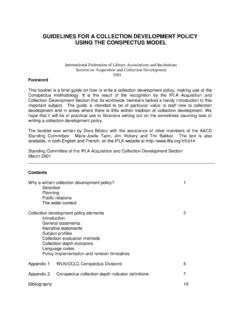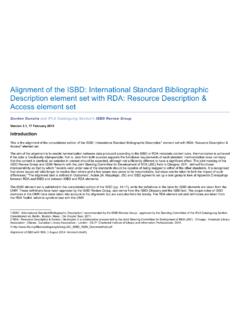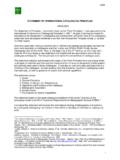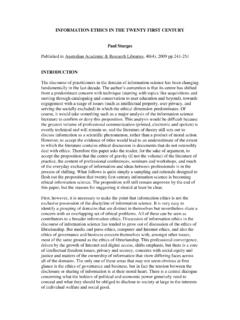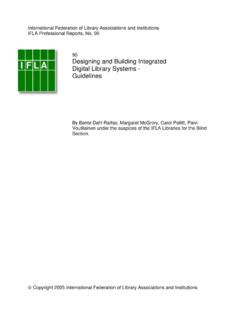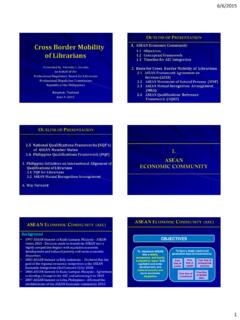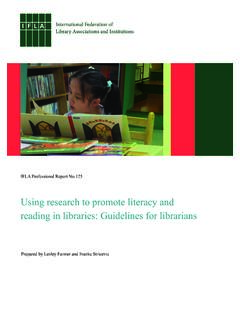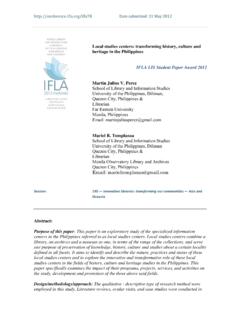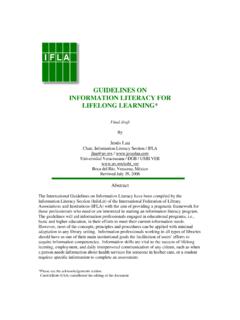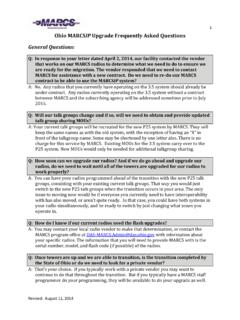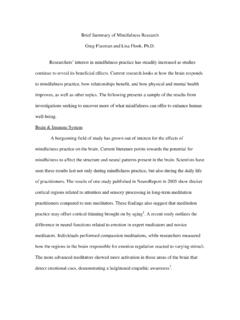Transcription of 1. What is MARC - International Federation of Library ...
1 Understanding the UNIMARC format1. what is MARC ?MARC is an acronym for Machine Readable Catalogue or Cataloguing. This general description,however, is rather misleading as MARC is neither a kind of catalogue nor a method of fact, MARC is a short and convenient term for assigning labels to each part of a catalogue recordso that it can be handled by computers. While the MARC format was primarily designed to serve theneeds of libraries, the concept has since been embraced by the wider information community as aconvenient way of storing and exchanging bibliographic original MARC format was developed at the Library of Congress in 1965-6 leading to a pilotproject, known as MARC I, which had the aim of investigating the feasibility of producingcatalogue data in machine-readable form.
2 Similar work was in progress in the United Kingdomwhere the Council of the British National Bibliography had set up the BNB MARC Project with theremit of examining the use of machine-readable data in producing the printed British NationalBibliography (BNB). These parallel developments led to Anglo-American cooperation on theMARC II project which was initiated in 1968. MARC II was to prove instrumental in defining theconcept of MARC as a communication II established certain principles which have been followed consistently over the years. Ingeneral terms, the MARC communication format is intended to be:Hospitable to all kinds of Library materialsSufficiently flexible for a variety of applications in addition to catalogue productionUsable in a range of automated systemsDespite cooperation there emerged several versions, UKMARC, INTERMARC and USMARC,whose paths diverged owing to different national cataloguing practices and requirements.
3 Since theearly 1970s an extended family of more than 20 MARC formats has grown up. Differences in datacontent means that editing is required before records can be solution to the problem of incompatibility was to create an International MARC format(UNIMARC) which would accept records created in any MARC format. So records in one MARC format could be converted into UNIMARC and then be converted into another MARC format. Theintention was that each national agency would need to write only two programs - one to convert into1 of 15 UNIMARC and one to convert from UNIMARC - instead of one program for each other MARC format, INTERMARC to UKMARC, USMARC to UKMARC in 1977 the International Federation of Library Associations and Institutes (IFLA) publishedUNIMARC : Universal MARC format, stating that "The primary purpose of UNIMARC is tofacilitate the International exchange of data in machine-readable form between nationalbibliographic agencies".
4 This was followed by a second edition in 1980 and a UNIMARC Handbookin 1983. All focussed primarily on the cataloguing of monographs and serials and took advantage ofinternational progress towards the standardisation of bibliographic information reflected in theInternational Standard Bibliographic Descriptions (ISBDs).In the mid-1980s it was seen necessary to expand UNIMARC to cover documents other thanmonographs and serials. So a new description of the format - the UNIMARC Manual - was producedin 1987. By this time UNIMARC had been adopted by several bibliographic agencies as theirin-house format. So the statement of purpose was amended to include "UNIMARC may also be usedas a model for the development of new machine-readable bibliographic formats".Developments did not stop there.
5 Increasingly a new kind of format - an authorities format - wasused. Previously agencies had entered an author's name into the bibliographic format as many timesas there were documents associated with him or her. With the new system they created a singleauthoritative form of the name (with references) in the authorities file; the record control number forthis name was the only item included in the bibliographic file. The user would still see the name inthe bibliographic record, however, as the computer could import it from the authorities file at aconvenient in 1991 UNIMARC/Authorities was that year users of UNIMARC realised that the occasional rewriting of manuals was not was needed was continuous maintenance. The Permanent UNIMARC Committee came intobeing that year, charged with regularly supervising the development of the format.
6 In maintainingthe format, care is taken to make changes upwardly compatible, no records created before achange would be invalid after latest development in the format has come about because of the requirement of EuropeanCommunity countries to produce unified specialised catalogues of their records. In order to producesuch unified catalogues they had to adopt a common format for them - The UNIMARC formatThe UNIMARC format, like any other version of MARC, involves three elements of thebibliographic record:Record structure2 of 15 The record structure is designed to control the representation of data by storing it in the form ofstrings of characters known as data in the record must be stored using one or more character sets. Since computers can storeand manipulate only numbers, each symbol, alphabetical character etc.
7 Is assigned a numberfollowing the rules of a particular character set. For example, one character set assigns the number'75' to 'K'. UNIMARC allows the use of certain character sets, approved by the InternationalOrganization for Standardization (ISO).The record structure established by UNIMARC is an implementation of the relevant standard:Format for bibliographic information interchange on magnetic tape (ISO 2709-1981). This structureutilises record labels and directories. As few users need concern themselves with such items, thedescription below covers the way a cataloguer sees the designationCertain conventions are followed in order to identify the data elements within records. Suchelements which include author, title and subject access are further characterised where supports the manipulation of the data for a variety of purposes:To provide multiple access points for searching,To allow the typography and layout to be varied,To permit certain elements of the record to be omitted where this is an example of such manipulation, see the "Displaying citations" section later in this addition, UNIMARC records may be formatted for visual display on a VDU, for output onCD-ROM or fiche and for printing out as hard general, UNIMARC provides content designation only for data which is applicable to all copiesof a work.
8 However, information which applies only to some copies (or even a single copy) of awork may be of interest beyond the holding institution. In such cases UNIMARC assigns specificfields for such details. These fields are also available for cases where the information is for in-housepurposes contentThe content is the data which is stored in the fields within the record. Data can be coded data orbibliographic data is used to represent such items as control numbers, publication type, and mainlanguage of text. There is also provision for the characteristics of special types of items suchas printed of 15 Bibliographic data is defined by reference to the International Standard BibliographicDescription for that type of material. In addition, each record can carry a class number andsubject purpose of UNIMARC, therefore, is to facilitate the description, retrieval and control ofbibliographic items.
9 This is achieved by providing a structure for recording bibliographicinformation which is input by reference to International The role of UNIMARCI nitially, UNIMARC was used for the exchange of records on magnetic tape but has since beenadapted for use in a variety of exchange and processing UNIMARC format is available to all agencies concerned with the exchange of bibliographicinformation. In practice, though, UNIMARC is orientated towards the requirements of fields, which are identified by three-character numeric tags, are arranged in functional blocks organise the data according to its function in a traditional catalogue record. In the tablebelow, fields 0-- - 1-- hold the coded data while fields 2-- - 8-- contain the bibliographic data:BlockExample0-- Identification block010 International Standard Book Number1-- Coded information block101 Language of the work2-- Descriptive information block205 Edition statement3-- Notes block336 Type of computer file note4-- Linking entry block452 Edition in a different medium5-- Related title block516 Spine title6-- Subject analysis block676 Dewey Decimal Classification7-- Intellectual responsibility block 700 Personal name - primary intellectualresponsibility8-- International use block801 Originating source9 - Reserved for local use In addition to the 9-- block any other tag containing a 9 is available for local fields defined by UNIMARC provide for different kinds and levels of information.
10 This can beshown by looking at a typical record in the UNIMARC Anatomy of a UNIMARC record4 of 15 Example: Alain-Fournier's novel "Le Grand Meaulnes", translated into English as "The lostdomain".001 0192122622@010##$a0-19-212262-2$d @020##$aUS$b59-12784@020##$aGB$bb5920618 @100##$a19590202d1959####|||y0engy0103## ##ba@1011#$aeng$cfre@102##$aGB$ben@105## $aac######000ay@2001#$a{NSB}The {NSE}lost domain$fAlain-Fournier$gtranslated from the French by FrankDavison$gafterword by John Fowles$gillustrated by Ian Beck@210##$aOxford$cOxford University Press$d1959@215##$aix,298p,10 leaves of plates$cill, $d23cm@311##$aTranslation of: Le Grand Meaulnes. Paris : Emile-Paul, 1913@454#1$1001db140203$150010$a{NSB}Le {NSE}Grand Meaulnes$1700#0$aAlain-Fournier$f1886- 1914$1210##$aParis$cEmile-Paul$d1913@500 10$a{NSB}Le {NSE}Grand Meaulnes$mEnglish@606##$aFrench @700#0$aAlain-Fournier,$f1886-1914@702#1 $aDavison,$bFrank@ @Before looking at the MARC fields in detail, it is important to understand how the coding definesthe data content.
